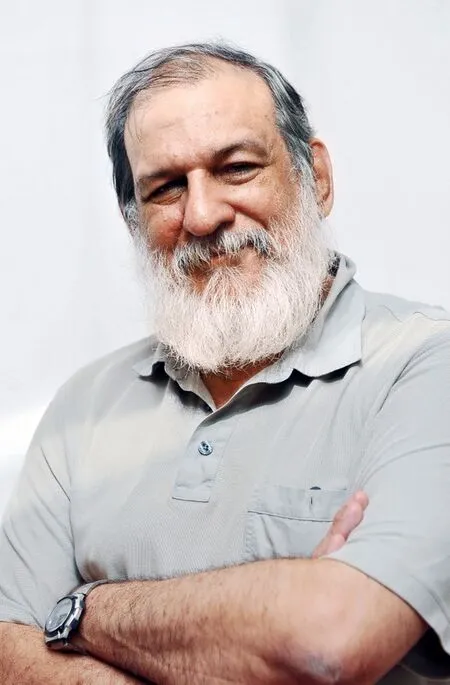中古合作,促进全球精准脑健康
2022-09-19PedroA.Valdes-Sosa,张佳艺
我出生在美国,父亲在美行医。古巴革命胜利后,我的家人于1962年回到了古巴。我们全家都希望为创造一个新的、更公正的社会作出贡献。
20世纪80年代末,古巴神经科学中心与中国建立合作
20世纪60年代末,作为一名医学生,我与纽约大学的Erwin Roy John教授一起,利用古巴的第一台计算机(1970年)开创了量化脑电图(qEEG)技术。时至今日,我们的目标仍是创造一种在群体层面协助诊断和管理大脑疾病的工具。1977年,我们在《自然》上发表了一篇神经计量学的论文,这即是我们本次合作的成果。我需要继续强化医学训练,这促使我从医学专业毕业后开始学习数学。后来,我领导的团队为世界上首批qEEG设备之一,即MEDICID系统构建了硬件和软件。
这一系列设备被引进到古巴的公共卫生系统,并最终在1990年进入中国以及欧洲与拉丁美洲的其他几个国家。1990年,我们与我的孪生兄弟Mitchell J. Valdes-Sosa一起成立了古巴神经科学中心(CNEURO)。作为一个研究、开发、生产、医疗服务和商业化的一体化机构,古巴神经科学中心率先创建了古巴国家临床神经生理学网络,并发起了一些倡议,如基于事件相关电位的国家听力筛查计划,以及国家治疗学习障碍计划。

Pedro A. Valdes-Sosa (古巴),古巴科学院院士、拉丁美洲科学院院士。2015年起,担任中国电子科技大学生命科学与技术学院教授。
在20世纪末,古巴神经科学中心的领导人已经确信,为在管理全球大脑疾病方面产生可衡量的影响,亟须建立国际联盟。出于种种考虑,中国成为这个联盟的自然候选人。在此先提一句,我的家庭与中国有着紧密联系。20世纪50年代,我的一位叔叔作为革命学生领袖访问了中国,见到了周恩来总理。两国建交后,我的母亲在古巴教授第一批访问古巴的中国人西班牙语。更重要的是,随着中国经济实力和国际影响力的提升,两国关系也越发牢固,造福人民是两国的共同目标。
因此,古巴神经科学中心在20世纪80年代末开始与中国的机构建立合作关系,引进了第一批qEEG系统。90年代,我第一次访问中国,担任中国早期qEEG会议的外方主席,后来还开设了关于古巴MEDICID系统的课程。2011年,我和朋友——中国科学院的蒋田仔和电子科技大学的尧德中访问了北京和成都。在他们的帮助下,我了解了中国脑科学的宏伟计划,发现了中国和古巴两国在神经科学上的互补性,并决心努力增进与中国机构的合作。随着工作关系的推进,我开始越来越多地待在中国。2015年,我被电子科技大学聘为神经信息学的特聘教授。
2015年,中国—古巴联合实验室成立
中国—古巴生物技术会议期间,在中国和古巴高层领导人的支持下,作为古巴神经科学中心和电子科技大学合作进程的关键点,2015年中国—古巴联合实验室在电子科技大学成立。我被任命为联合实验室的主任。我的任务是:在电子科技大学创建一个高度国际化的实验室,促进国际合作;继续开发以脑连接为重点的新的生物物理方法,将其用于神经影像学;使神经影像学,特别是qEEG技术在所有卫生系统应用;建立国际网络,服务于全球精准脑健康。
2015年以来所发生的一切证明了我们的计划正在逐渐实现。很幸运,我得到了电子科技大学和中国科研机构的支持。中国—古巴联合实验室已经成为电子科技大学最国际化的实验室之一,其学生和工作人员来自古巴、中国、坦桑尼亚、卢旺达、巴基斯坦、也门和尼日利亚,已经有3名博士生和17名硕士生从这里毕业。实验室已经在索引期刊上发表了70多篇论文,其中许多见刊《自然》系列杂志。我们还建立起一个个性化医疗院士站,来自古巴的5位院士参与其中,共形成8篇论文。
随着这一国际平台的建立,2017年,在哈瓦那举行的一次会议之后,魁北克研究基金会医学部、古巴环境与科技部、中国国家自然科学基金委员会批准了中国(成都)—加拿大—古巴脑计划项目(C-C-C项目),以创建一个神经影像和神经信息学平台。该平台可为协调寻找衰老相关疾病的生物标志物和治疗方法、招募全球领先的大脑项目、激励中低收入国家奠定基础。
古巴国家电视新闻播出了最近在哈瓦那科学中心举办的古巴大脑项目启动仪式,古巴总统Miguel D az-Canel也出席了本次仪式。C-C-C项目被推介给古巴政府和公众,强调了与中国开展国际合作的价值。
很明显,对跨国脑成像网络的需求在C-C-C项目之后不断增加,这将有助于解决神经科学领域一些最重要的问题。信息技术在数据共享方面的最新进展、资助者的鼎力支持以及蓬勃发展的开放科学文化,为有意义的国际科学参与带来了新的希望。
2019年,全球人脑图表联盟创建
事实证明,由于各种技术、组织、伦理和社会政治原因,全球科学家聚集在一起合作是十分困难的。我们必须同心协力,依靠科学家、技术开发人员和资助者共同制定战略来实现这一目标。因此,C-C-C项目需要将合作经验扩展到其他国家,包括美国、欧洲、亚洲和澳大利亚的合作伙伴。这促使我和蒙特利尔神经研究所的Alan Evans在2019年创建了国际人脑图表联盟(GBC)。作为C-C-C的延伸,GBC专注于人类神经影像学及其与基因组学和行为数据的集成,以加速我们对大脑状态的时空动力学的理解。这些知识对于理解神经发育、神经可塑性和疾病进展至关重要。在最初的战略决策中,EEG是首选的神经影像技术,因为其具有低成本、便携性和非侵入性的优势。因此,这些发现可以作为转化研究的桥梁,满足得不到充分服务的人群的需求。相信我们的研究结果可以成为中低收入国家进行全球精准脑健康研究的基础,为那些精神疾病负担最重但也最难获得昂贵成像技术的地方提供帮助。
GBC已经吸引了包括世界卫生组织在内的9个国际组织的150多名研究人员,他们来自23个国家。我们的合作产出了一些论文,这些论文现已被列入《神经成像》杂志中关于全球健康的特刊。其中有两项合作项目值得一提,它们均强调了多国合作的必要性和可能性,可以使中低收入国家受益。
第一个项目是巴巴多斯、美国、加拿大和古巴之间的合作,旨在研究仅发生在生命第一年的蛋白质能量营养不良的终身影响。一项独一无二的49年追踪研究为对早期蛋白质能量营养不良的参与者在学龄时和45年后成年时进行qEEG研究提供了可能性。
qEEG能够清楚地识别这两个年龄段的大脑功能障碍。研究结果显示,早期qEEG老化的指标似乎与早期认知衰退有关。由于全球儿童营养不良情况的增多,这一发现可推动开发疾病进展模型和生物标志物以预防这些后果。在所述的营养不良研究中,qEEG的效用强调了拥有全球有效的qEEG规范性数据的重要性。
要强调的第二个项目是GBC多国项目,该项目为来自9个国家的超过1564人创建了黎曼规范,涵盖了从5岁到97岁的年龄范围。
通过创建平台来拥有一个科学焦点,用以解决重要的技术问题并产生全球影响,这是一种困难的平衡行为。现代神经科学拥有大量理论、建模和神经影像技术,但其中许多设备在中低收入国家是不容易获得的。
幸运的是,近年来,由于对脑计划的投入增加,一系列数字和神经技术的使用得到加强,这可能有助于我们弥合不同国家间的差距。这将为中低收入国家的神经科学家和临床医生提供合作机会,而这些人恰恰是以往在全球伙伴关系倡议中被忽视的群体。
扩展合作推动脑科学发展
我对未来的期望是竭力推动低成本、可负担的神经影像技术在中低收入国家的部署,推动大脑疾病研究发展,并希望减少巨大的心理健康负担。
我有意建立一个中国—古巴联合实验室,作为“一带一路”倡议的一部分,在两国范围内研究老龄化并推出高科技产品。这一想法在成都、上海等地受到极大欢迎,一些科研机构公开表明了对这项合作倡议的兴趣。之后,我想把合作扩展到其他国家,如墨西哥、巴西、巴基斯坦和马来西亚。
我希望能够继续推动GBC,巩固中国和古巴在开发适合中低收入国家的技术方面的效用。我还希望为脑电图规范、营养不良的大脑后果、痴呆症和帕金森病的早期生物标志物、儿童和青少年大脑发育的纵向生物标志物,以及CIBD(新冠肺炎诱发的大脑疾病)等创立项目。
CIBD的项目说明了开发可扩展技术以帮助诊断大脑功能障碍的重要性和挑战性。由于需要筛查和管理的人数众多,大脑研究的目标有必要进行革命性的改变。我和Mitchell Valdes-Sosa、Alan Evans、蒲慕明共同撰写了一篇呼吁在这一领域采取国际行动的文章,发表在了《国家科学评论》上。
在提供足够的资源和可能的社会影响以开展研究方面,世界上任何一个国家都不能和中国媲美。尽管前路漫漫,但我为中国和中国同事给予我支持而感到幸运。我结识了许多至交好友。中国政府对我的努力给予了极大的支持,我为获得2017年度中国政府友谊奖以及受邀参加中华人民共和国成立70周年庆祝活动而倍感自豪。
I was born in the United States, where my father practiced medicine. However, my family returned to Cuba in 1962, following the triumph of the Cuban Revolution. The entire family was motivated by the desire to contribute to creating a new and more just society.
In the Late 1980s, Cuban Neuroscience Center Started Cooperation with China
As a medical student in the late 1960s, jointly with Prof. Erwin Roy John from NYU, I harnessed the first Cuban computer (1970) to pioneer methods for the quantitative analysis of the electroencephalogram (qEEG). Our objective was (and still is) to create tools that can assist in the diagnosis and management of Brain disorders at population levels. This collaboration resulted in a “Science” paper on Neurometrics in 1977. I had to complement my medical training, and this prompted me to study mathematics after graduating from medicine. I later led the team that built the hardware and software for one of the first qEEG devices in the world, the MEDICID system.
This family of equipment was introduced into Cuba’s public health system and eventually reached China in 1990, as well as several other countries, including Europe and Latin America. We founded the Cuban Neuroscience Center (CNEURO) in 1990 with my twin brother Mitchell J. Valdes-Sosa as an institution carrying out the complete cycle of research, development, production, medical services, and commercialization. CNEURO spearheaded the creation of the Cuban National Network for Clinical Neurophysiology and launched initiatives like the national hearing screening program using Event-related potentials and a national program for detecting and treating learning disabilities.
At the end of the 20th century, the leaders of CNEURO had become convinced that international alliances were required to achieve our goal of having a measurable effect on the management of the staggering global burden of brain disorders. For many reasons, China was a natural candidate for this alliance. First, my family had close ties with China. In the 1950s, one of my uncles visited the new China as a revolutionary student leader and met Premier Zhou Enlai. In Cuba, my mother taught Spanish to the first Chinese to visit Cuba after mutual diplomatic recognition. More importantly, as China’s economy and international influence developed, so did the strong relations between the two nations, which shared similar goals of benefitting their populations.
As a result, CNEURO initiated relations with Chinese institutions in the late 1980s, introducing, as I already mentioned, some of the first qEEG systems used here. I visited China for the first time in the 1990s to be the foreign chair of an early Chinese qEEG conference and later give a course on the Cuban MEDICID systems. My first encounters followed these initial contacts in 2011 during a visit to Beijing and Chengdu with my friends Tianzi Jiang from the Chinese Academy of Sciences and Dezhong Yao of University of Electronic Science and Technology of China (UESTC). Owing to them, I learned about the ambitious plans for Chinese Brain Science, discovered the complementary nature of Cuban and Chinese neuroscience, and began working to increase the international relations of the Chinese institutions I worked with. As our working relations grew, I started spending more time in China. In 2015, UESTC appointed me a Distinguished Professor of Neuroinformatics.
In 2015, the China-Cuba Joint Lab was Established
As a culmination of this integration process of the work of CNEURO and UESTC, the China-Cuba Joint Lab at UESTC was created in 2015 during the China-Cuba Bi-National meeting for Biotechnology with the enthusiastic support of high-level Cuban and Chinese leaders. Designated as the first Director of the Joint Lab, this coincided with my appointment as a foreign expert at UESTC. The tasks that UESTC and CNEURO charged me with were: To create a highly international laboratory within UESTC that would foster international collaborations. To continue developing new biophysical methods for Neuroimaging with emphasis on Brain Connectivity. To introduce neuroimaging, particularly qEEG methods applicable in any health system. To establish international networks that would work for Global Precision Brain Health.
What has occurred since 2015 has vindicated our intentions. I have been fortunate in the support received by UESTC and the Chinese Scientific establishment. The China-Cuba Joint Lab has become one of the most international ones of UESTC, with students and staff from Cuba, China, Tanzania, Rwanda, Pakistan, Yemen, and Nigeria. We have graduated 3 Ph.D Students and 17 Master’s students. The lab has published over 70 papers in indexed journals, many of them from the Nature family. With UESTC, we also established an Academician Station for Personalized Medicine that brought five Academicians from Cuba, resulting in eight collaborative papers.
With this international platform in place, in 2017, following a meeting in Havana, the Fonds de recherche du Québec - Santé (FRQS), the Ministry of Science, Technology, and Environment (CITMA) of Cuba, and the National Science Foundation of China (NSFC) approved the so-called China (Chengdu)-Canada-Cuba Brain Mapping Project (CC-C Project) to create a Neuroimaging and Neuroinformatics Platform (NNP) that would set the stage for the coordinated search for biomarkers and treatments for aging-related disorders in the three countries, the recruitment for this research of the leading global brain projects as well as stimulating initiatives in Low- and Middle-Income Countries (LMIC) .
The launch of the most recent Cuban Brain Project at the Scientific Pole of Havana was broadcasted on the Cuban National TV News in the presence of the Cuban President Miguel Díaz-Canel. The C-C-C project was conveyed to the Cuban Government and the general public, thereby underscoring the value of international collaboration with China.
Following the C-C-C Project, it became evident that there is a rising demand for transnational brain imaging networks that will help us tackle some of the biggest questions in neuroscience. Recent advancements in information technology to mediate data-sharing, dedicated support from funders, and a burgeoning culture of Open Science offer new hope for meaningful scientific engagement internationally.

Pedro A. Valdes-Sosa教授获得2017年度中国政府友谊奖
In 2019, the Global Brain Consortium was Created
Bringing scientists across the globe together to collaborate has proven difficult for various technical, logistical, ethical, and socio-political reasons. We must work together—scientists, technology developers, and funders to devise strategies to make this happen. Therefore, the C-C-C needed to extend the experience of collaboration across other borders and include partners of the US, Europe, Asia, and Australia. This led Alan Evans from the Montreal Neurological Institute and me to create the Global Brain Consortium (GBC) in the year 2019. As an extension of the C-C-C, the GBC focuses on human neuroimaging and its integration with genomics and behavioral data to accelerate our understanding of the spatiotemporal dynamics of brain states. This knowledge will be essential for comprehending neurodevelopment, neuroplasticity, and disease progression. EEG was chosen as the preferred neuroimaging technique in an initial strategic decision. This position was due to the advantages of EEG in terms of low-cost effectiveness, portability, and non-invasiveness. Therefore, the findings can serve as a translational research bridge to address the needs of underserved populations. We believe that our results can be the basis for global precision brain health research in LMIC, making a difference where the burden of mental disorders is highest but access to where expensive imaging technologies is most limited.
The GBC has engaged over 150 researchers from 23 countries and nine international organizations, including the World Health Organization. Our collaboration has generated papers that have now been included in a special issue about Global Health in Neuroimage. Two of the collaborations published in that issue should be mentioned because they underscore the need and possibility of multinational collaborations that can benefit LMIC.
The first example is a collaboration between Barbados, the United States, Canada, and Cuba to study the lifelong effects of Protein Energy Malnutrition (PEM) that occurs only in the first year of life. A unique 49-year longitudinal study offered the possibility of studying the qEEG of participants with early PEM at school age and when they were adults 45 years later.
The qEEG enabled the clear identification of brain dysfunctions at both ages, with what appear to be indicators of early qEEG aging related to early cognitive decline as a conclusive result. As a result of the increase in child malnutrition globally, this finding may pave the way to develop disease progression models and biomarkers to help prevent these consequences. The utility of qEEG demonstrated in the described malnutrition study underscores the importance of having globally valid qEEG normative data.
The second result we want to highlight is the GBC multinational Project, which created Riemannian norms for over 1,564 persons from 9 countries, covering the age range from 5 to 97 years.
It’s a difficult balancing act to create a platform that allows us to have a scientific focus, tackle important technology issues, and have a global impact. Modern neuroscience has a considerable arsenal of theoretical, modeling, and neuroimaging technologies, but many of these devices are not readily available in LMIC.
Fortunately, access to an array of digital and neuro-technologies, which has been enhanced in recent years due to the investment of the Big Brain initiatives, may help us bridge this essential gap. This will open collaborative opportunities for neuroscientists and clinicians in LMIC who have previously been overlooked in global partnership initiatives.
Expand Cooperation and Promote the Development of Brain Science
My expectation for the future is to push harder for the deployment of low-cost, affordable neuroimaging technologies in LMIC to study brain disorders and potentially decrease the enormous mental health burden.
I intend to establish a China-Cuba Joint Lab as part of the Belt and Road Initiative to study aging and launch high technological products in both countries. This idea has been received with great enthusiasm in Chengdu, Shanghai, and other places, where several scientific institutions publicly declared their interest in a joint initiative. Later, I would like to extend the collaboration to other countries like Mexico, Brazil, Pakistan, and Malaysia.
I wish, of course, to boost the Global Brain Consortium (GBC), cementing China and Cuba’s role in developing technologies appropriate for LMIC. I also wish to build our programs for EEG norms, Brain Consequences of Malnutrition, Early Biomarkers of Dementia and Parkinson’s, Longitudinal biomarkers of child and adolescent brain development, and COVID induced Brain Disorders (CIBD).
This last program of CIBD illustrates the importance and challenges of developing scalable technologies to aid in diagnosing brain dysfunctions. The sheer number of people that need to be screened and managed necessitates a revolutionary change in the objectives of brain research. Mitchell Valdes-Sosa, Alan Evans, Mu-ming Poo, and I wrote a call to international action in this field, which was published in the National Science Review.
There is nowhere in the world that provides possibilities to carry out research with adequate resources and possible social impact as China. Although there is still much to accomplish, I feel truly fortunate for the support given by China and my Chinese colleagues. I have made beautiful friends. The Chinese Government has been extremely supportive of my efforts. I am particularly proud of receiving the 2017 Chinese Government Friendship Award and being invited to participate in the parade to commemorate the 70th anniversary of the PRC.
